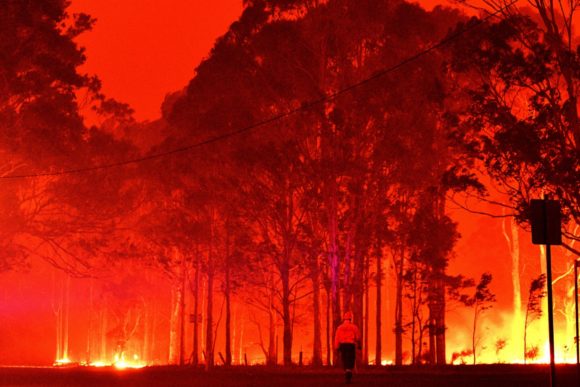Insurance industry losses from natural catastrophes and man-made disasters across the globe amounted to US$83 billion in 2020, making it the fifth-costliest year for the industry since 1970, according to the Swiss Re Institute in its preliminary sigma estimates.
Natural catastrophes caused US$76 billion of global insured losses, up 40% from 2019, mostly from secondary peril events such as severe convective storms (thunderstorms with tornadoes, floods and hail) and wildfires in the U.S. In addition, manmade insured losses came to $7 billion in 2020, down 17% from the previous year.
Secondary perils* accounted for 70% of the US$76 billion in insured losses from natural catastrophes, said Swiss Re. These secondary peril events are expected to increase as more humid air and rising temperatures create extreme weather conditions, which exacerbate wildfires, storm surges and floods.
The North Atlantic hurricane season was very active with a record 30 named storms, but its insurance price tag of US$20 billion was moderate compared to the record seasons of 2005 and 2017, said Swiss Re.
Although five named storms made landfall in the U.S. state of Louisiana alone, a record number, the report noted that most U.S. landfalls did not hit densely populated areas in 2020.
As a result, the insurance industry saw relatively low insured losses of US$20 billion, far lower than in the previous record hurricane seasons of 2017 (when Hurricanes Harvey, Irma and Maria had an insured price tag of US$97 billion) and 2005 (when Hurricane Katrina cost insurers US$87 billion).
The report went on to say that the insurance industry covered 45% of 2020’s global economic losses of $187 billion, above the 10-year-average of 37% (which indicates a narrowing of the insurance protection gap). (Editor’s note: Economic losses include insured and non-insured damage costs).
“As with COVID-19, climate change will be a huge test of global resilience. Neither pandemics nor climate change are ‘black swan’ events. But while COVID-19 has an expiry date, climate change does not, and failure to ‘green’ the global economic recovery now will increase costs for society in future,” said Jerome Jean Haegeli, Swiss Re Group chief economist, in a statement.
“This year’s natural disasters impacted regions with more insurance cover in place, providing vital support to the people and communities affected and enhancing their financial resilience,” he continued.
Other findings from the report include:
- A record number of severe convective storms hit the U.S., which will likely lead to record annual losses for this peril.
- Australia saw significant losses from hailstorms, including January storms in southeastern Australia, which cost insurers more than US$1 billion.
- Canada experienced its costliest-ever hail event in Calgary in June with losses of US$1 billion.
- Although less than the record wildfire losses of 2018 and 2017, 2020 will be one of the costliest for the U.S. and Australian fire seasons. (See related article: RMS Says Insured Losses from 2020 Western U.S. Wildfires $7-$13B)
- Secondary perils during 2020 included severe floods in several provinces along the Yangtze River in China from May, causing insured losses of roughly US$2 billion.
- Winter storms hit northern Europe in February, causing flooding, power outages and transport disruption, with more than US$2 billion in insured losses.
- Cyclone Amphan in the Bay of Bengal in May caused economic losses of US$13 billion, the most destructive tropical cyclone India has ever experienced. Insured losses are expected to be just a fraction of the economic losses due to the region’s low insurance penetration.
Swiss Re Institute said it will publish updated 2020 loss figures in a full sigma report in the spring of 2021.
* Swiss Re defined two types of events as secondary perils: (a) independent, high frequency event (i.e., more frequent than primary peril events such as earthquakes and hurricanes), low-to-medium severity loss events (relative to losses resulting from primary perils); and (b) events that occur as secondary effects of primary perils, such as a tsunami following an earthquake.
Source: Swiss Re
Photograph: A firefighter walks past burning trees during a battle against bushfires around the town of Nowra in the Australian state of New South Wales on Dec. 31, 2019. Thousands of holidaymakers and locals were forced to flee to beaches in fire-ravaged southeast Australia, as blazes ripped through popular tourist areas leaving no escape by land. Photo credit: Saeed Khan/AFP via Getty Images.
Was this article valuable?
Here are more articles you may enjoy.



 ‘Great Resignation’ Enters Third Year as Workers Embrace AI, Upskilling, PwC Says
‘Great Resignation’ Enters Third Year as Workers Embrace AI, Upskilling, PwC Says  GEICO Tops Progressive With Higher J.D. Power Scores
GEICO Tops Progressive With Higher J.D. Power Scores  Coverage Needed: Hundreds of Thousands in SE Now in Flood Zones With New Maps
Coverage Needed: Hundreds of Thousands in SE Now in Flood Zones With New Maps  Big ‘I’ Report: Independent Agency Channel Placed 62% of Premiums in 2023
Big ‘I’ Report: Independent Agency Channel Placed 62% of Premiums in 2023 

